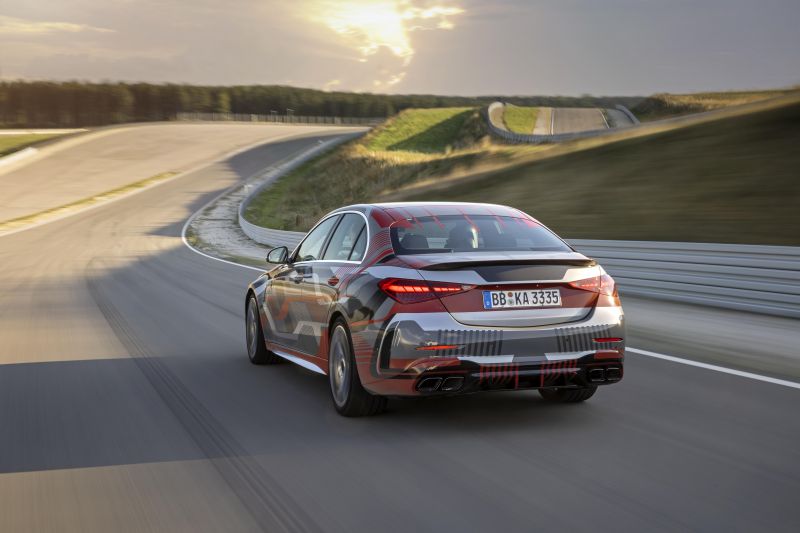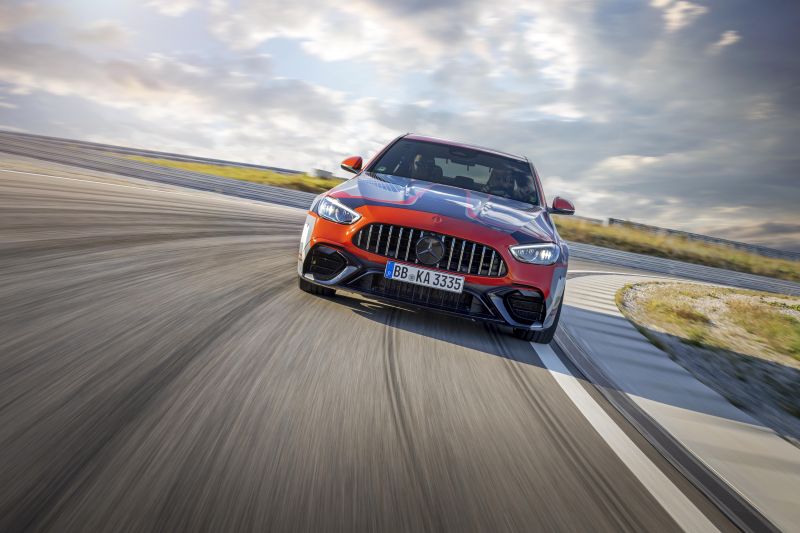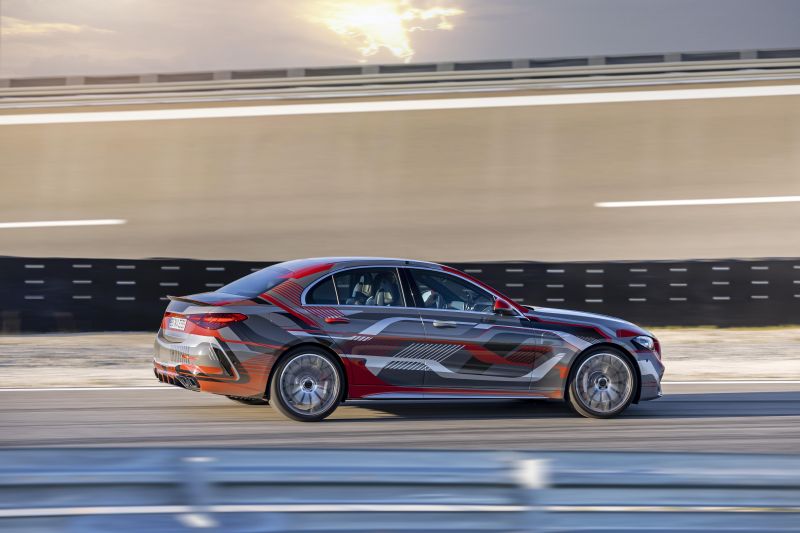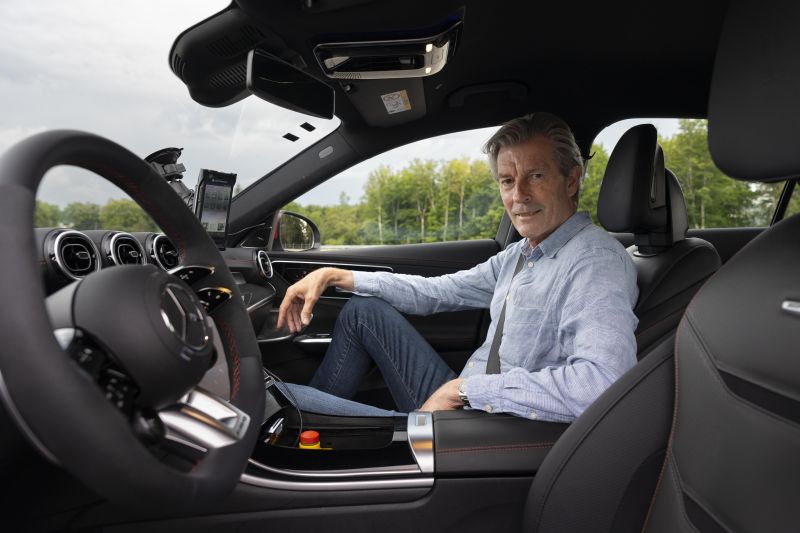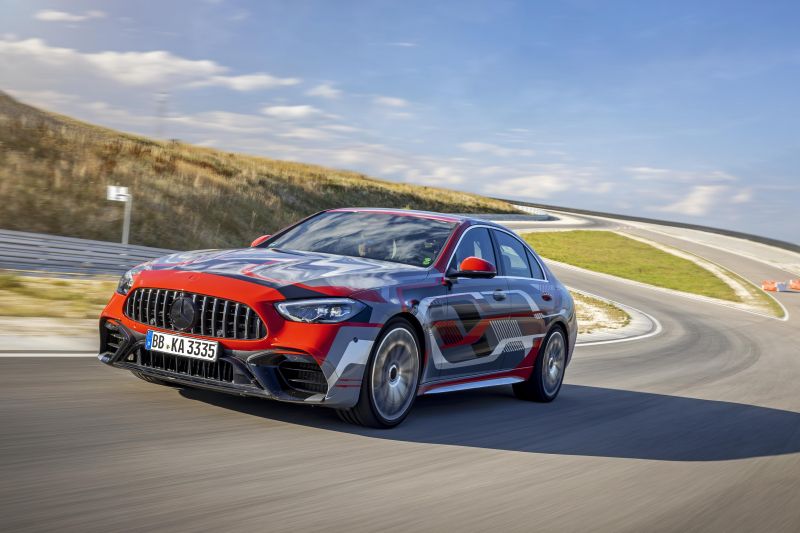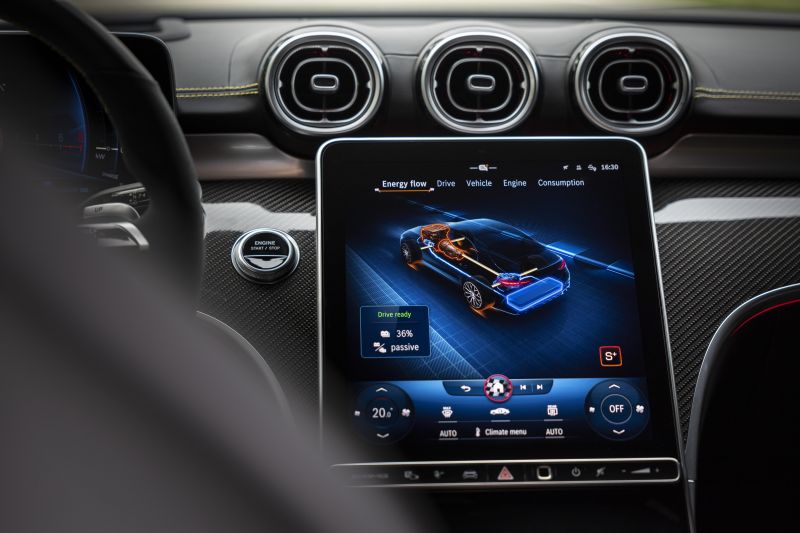The bad news? It doesn’t have that rolling thunder V8 rumble. The good news? It doesn’t matter.
Performance isn’t noise. Performance is acceleration and grip and speed and a chassis that lets you explore its limits with calm confidence. And the new Mercedes-AMG C63 S E Performance has all that in abundance.
“We could have just done another V8 C63,” says AMG chief technical officer Jochen Hermann as he wheels a camo’d C63 S E Performance prototype onto the challenging 4km racetrack buried in the heart of Mercedes-Benz’s sprawling Immendingen proving ground, south of Stuttgart.
“But we would have been stuck in the past.”
Hermann smiles as he twirls the controller under the right-hand spoke of the steering wheel and selects Race mode.
“I am no racing driver,” he says. He’s still smiling as he punches the throttle.
A deep baritone snarl erupts from up front, accompanied by instant-on, neck-snapping acceleration as all four wheels claw at the tarmac. The AMG Speedshift transmission bam-bam-bams through a lightning-quick series of upshifts.
Corner! Hermann’s hard on the brakes as the Speedshift works back through the gears. Clip the apex then hard on the power. The snarling AMG slingshots down the track.
This new C63 doesn’t sound like the old ones we’ve come to know and love. It doesn’t quite go like them, either. It’s much harder, more instant, more urgent, more intense. V8? Who needs a V8? That’s so old school.
Boasting 500kW and a thumping 1020Nm, this four-cylinder, plug-in hybrid C63 is the most powerful C63 ever.
It’ll sprint from 0 to 100km/h in 3.4 seconds, making it quicker than the 4.0-litre twin-turbo V8-powered car it replaces, and the 6.2-litre naturally aspirated V8-powered C63 before that. And, it’ll hit 280km/h on the autobahn with the optional AMG Driver’s Package fitted.
The C63 S E Performance’s hybrid powertrain consists a 350kW version of AMG’s 2.0-litre turbocharged inline four under the bonnet and a 150kW e-motor mounted on the rear axle.
Although the little four-banger, codenamed M139l, is the most powerful production four-cylinder internal combustion engine in the world, and is the first production engine with a turbocharger spun by a 400V electric motor rather than exhaust gases, at first glance there’s nothing particularly remarkable about either powerplant. What is remarkable is how they work together to deliver the new C63’s explosive performance.
The M139l drives all four wheels through the AMG Speedshift multi-clutch nine-speed automated transmission. The e-motor drives the rear wheels through its own automated two-speed transmission, which shifts to high gear at 140km/h when the e-motor reaches its 13,500rpm limit, and is integrated with an electronically controlled limited-slip differential.
It can also send drive forward via a separate propellor shaft to a clutch unit at the rear of the nine-speed transmission, from which it can be distributed to the front wheels.
Enabling each powerplant to independently supply its power and torque outputs to the drivetrain means that each can play to its strengths.
If the ICE and the e-motor shared the same output shaft, as is the usual practice with many hybrids, the system could not deliver maximum power because the power peaks of both occur at different revs, says AMG development engineer Peter Szalay.
The sounds entirely logical in principle. However, making it work in practice requires F1-level powertrain management techniques and technologies.
Jochen Hermann says many of the learnings from the AMG One hypercar program, where engineers had to figure out how to get a 1.6-litre F1 V6 that in race-spec idles at 5000rpm and revs to 15,000rpm, be street-driveable and meet emissions and play nice with the car’s four electric motors, have gone into executing the new C63’s hybrid powertrain.
Key to making the powertrain concept work is an AMG-developed 400V electrical architecture and a high-performance 6.1kWh battery mounted at the rear of the car. The 89kg battery can be recharged by via a plug and will drive the C63 S E Performance up to 13km on pure electric power at speeds of up to 125km/h.
But that’s not what the battery is primarily designed to do. “We don’t care about range,” says Jochen Hermann, “the battery is there for performance.” Just like the battery in a Mercedes F1 car’s hybrid powertrain.
In the C63 S E Performance, the battery provides a continuous output of 70kW and can sustain a peak output of 150kW for 10 seconds, and is able to be replenished rapidly, either by the engine or via recuperation rates of up to 120kW under heavy braking or in the highest of the four available regen settings.
To cope with that sort of punishment, it features a cooling system that circulates a high-tech coolant directly around each of its 580 cells to ensure it’s always at the optimal temperature – around 45 degrees, says AMG – to deliver maximum performance.
As a result, a kickdown function ensures the full 150kW of the e-motor is available on demand in any of the C63’s eight drive modes.
Even from the passenger seat, the new C63 S E Performance feels like a next-level AMG performance car.
High-performance turbocharged internal combustion engines can feel doughy at the bottom end, and pure EVs strangled at the top end – but the C63 S E Performance’s powertrain simply delivers a relentless surge of thrust right the way through its speed range.
And you’re never aware of which part of the powertrain is doing what to make that happen. It’s seamless.
This is the first all-wheel drive C63, and that’s a good thing. Sophisticated control systems mean none of the C63 S E Performance’s immense power and torque is wasted.
The standard rear-wheel steering, which turns the rear wheels up to 2.5 degrees in the opposite direction to the fronts at lower speeds, helps the Mercedes dive cleanly into tighter corners. The wider front track, and the staggered tire setup – our car was rolling on 265/35 ZR20 fronts and 275/35 ZR20 rears – made it feel resolutely planted through fast sweepers.
Braking is strong, thanks to the AMG carbon-ceramic brake system. In Race mode the four-level energy recuperation system is automatically set at Level 1, which emulates the lift-off feel of a regular internal combustion engine car with a manual transmission so that the chassis balance and behaviour is like that of a normal high-performance car.
At 2111kg the new C63 weighs a hefty 326kg more than the previous model – batteries and e-motors are heavy – but as most of the extra mass is located towards the rear axle it has a perfect 50/50 front-to-rear weight distribution, compared with the old car’s 54/46 front to rear weight bias.
It might be the most potent C63 yet, but it’s not all sturm und drang all the time.
Driven in pure EV mode on the access roads around the proving ground, the E Performance oozed smoothly and quietly along, the ride feeling surprisingly supple.
The default drive mode is Comfort, in which the e-motor and the ICE mix and match outputs to deliver the maximum efficiency, with the e-motor limited to about 25 per cent of its maximum output. Sport mode allows up to 65 per cent of the e-motor’s output to be used, and Sport+ mode 80 per cent.
As mentioned earlier, four levels of lift-off recuperation are available.
In Level 0 the powertrain coasts like a conventional manual transmission car with the clutch disengaged, prompting a very low recuperation level that’s used only to maintain the vehicle’s power supply.
Level 3 allows pure EV-style one-pedal driving, something most hybrids can’t do because they don’t have the battery cooling. In Level 3, the e-motor can send up to 100kW back to the battery as it slows the car.
We’ll reserve judgement until we’ve had a chance to get behind the wheel, of course, but on first acquaintance, the C63 S E Performance is a deeply impressive piece of work. It’s more than a one-dimensional road rocket.
It’s a car that’s able to effortlessly adjust and adapt to a wide variety of different driving environments. Most importantly, it feels, even from the passenger seat, like huge fun to drive. It still has that AMG DNA.
“It is so much more than just a new C63,” says Jochen Hermann, “I think we made it more grown up as a car.”
Click the images for the full gallery





